TOYOTA TACOMA 2014 Owners Manual (in English)
Manufacturer: TOYOTA, Model Year: 2014, Model line: TACOMA, Model: TOYOTA TACOMA 2014Pages: 601, PDF Size: 11.67 MB
Page 241 of 601
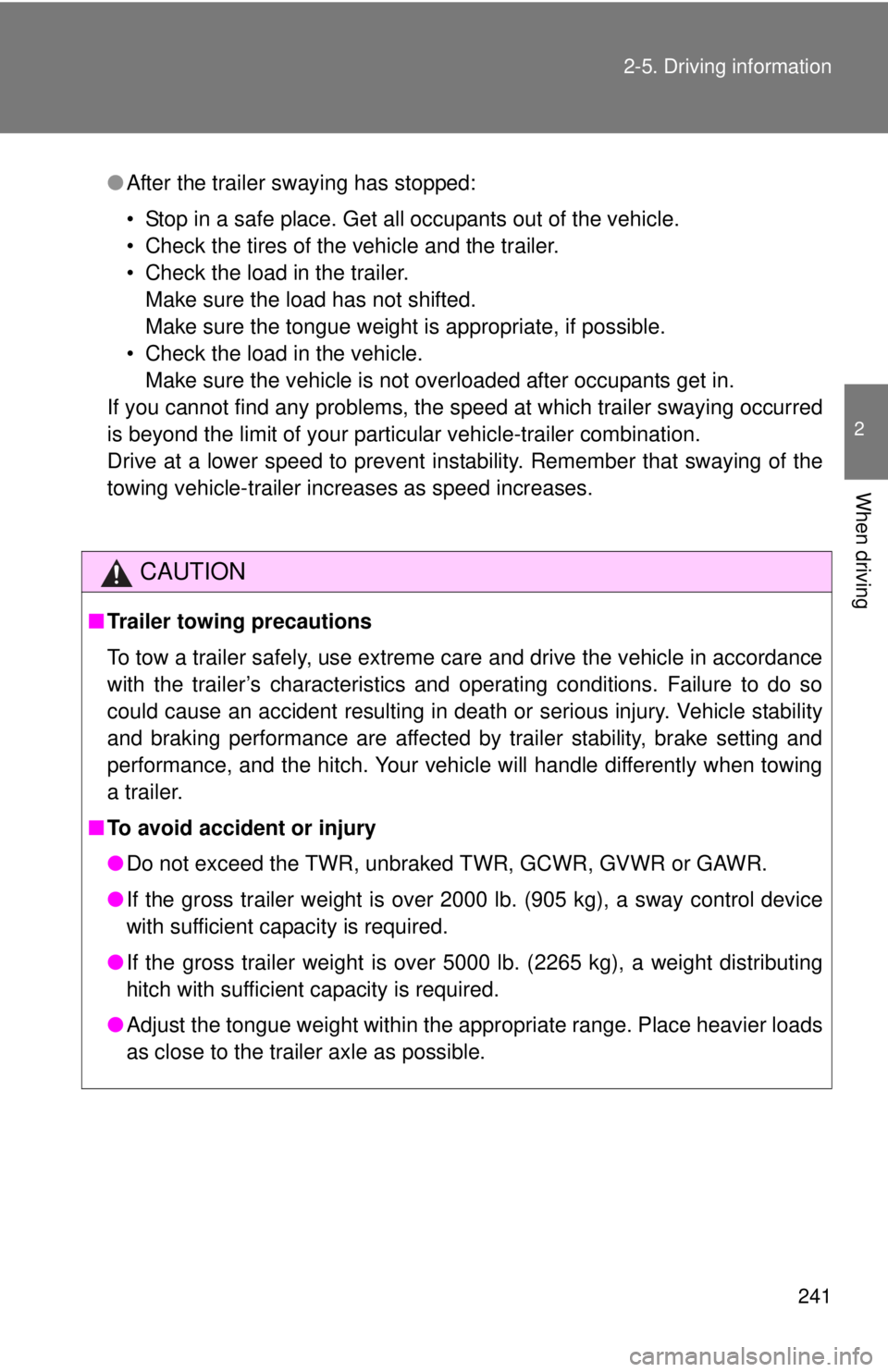
241
2-5. Driving information
2
When driving
●
After the trailer swaying has stopped:
• Stop in a safe place. Get all occupants out of the vehicle.
• Check the tires of the vehicle and the trailer.
• Check the load in the trailer.
Make sure the load has not shifted.
Make sure the tongue weight is appropriate, if possible.
• Check the load in the vehicle. Make sure the vehicle is not overloaded after occupants get in.
If you cannot find any problems, the speed at which trailer swaying occu\
rred
is beyond the limit of your particular vehicle-trailer combination.
Drive at a lower speed to prevent instability. Remember that swaying of the
towing vehicle-trailer increases as speed increases.
CAUTION
■ Trailer towing precautions
To tow a trailer safely, use extreme care and drive the vehicle in accordance
with the trailer’s characteristics and operating conditions. Failure to do so
could cause an accident resulting in death or serious injury. Vehicle stability
and braking performance are affected by trailer stability, brake setting and
performance, and the hitch. Your vehicle will handle differently when towing
a trailer.
■ To avoid accident or injury
●Do not exceed the TWR, unbraked TWR, GCWR, GVWR or GAWR.
● If the gross trailer weight is over 2000 lb. (905 kg), a sway control device
with sufficient capacity is required.
● If the gross trailer weight is over 5000 lb. (2265 kg), a weight distributing
hitch with sufficient capacity is required.
● Adjust the tongue weight within the appropriate range. Place heavier loads
as close to the trailer axle as possible.
Page 242 of 601

242 2-5. Driving information
CAUTION
■To avoid accident or injury
●Do not exceed 65 mph (104 km/h), the posted towing speed limit or the
speed limit for your trailer as set forth in your trailer owner’s manual,
whichever is lowest. Slow down sufficiently before making a turn, in cross
winds, on wet or slippery surface, etc. to help avoid an accident. If you
experience a vehicle-trailer instability from reducing a certain speed, slow
down and make sure you keep your vehicle speed under the speed of
which you experience the instability.
● Do not make jerky, abrupt or sharp turns.
● Do not apply the brakes suddenly as you may skid, resulting in jackknifing
and loss of vehicle control. This is especially true on wet or slippery sur-
faces.
● Do not exceed the trailer hitch assembly weight, gross vehicle weight,
gross axle weight and trailer tongue weight capacities.
● Do not use cruise control when towing.
● Slow down and downshift before descending steep or long downhill
grades. Do not make sudden downshifts while descending steep or long
downhill grades.
● Vehicle-trailer instability is more likely on steep long downhills. Before
descending steep or long downhill grades, slow down and downshift. Do
not make sudden downshifts when descending steep or long downhill
grades. Avoid holding the brake pedal down too long or applying the
brakes too frequently. This could cause the brakes to overheat and result
in reduced braking efficiency.
● Do not tow a trailer when the temporary spare tire is installed on your vehi-
cle.
■ Hitch
Trailer hitch assemblies have different weight capacities established by the
hitch manufacturer. Even though the vehicle may be physically capable of
towing a higher weight, the operator must determine the maximum weight
rating of the particular hitch assembly and never exceed the maximum
weight rating specified for the trailer-hitch. Exceeding the maximum weight
rating set by the trailer-hitch manufacturer can cause an accident resulting in
death or serious personal injuries.
Page 243 of 601

243
2-5. Driving information
2
When driving
CAUTION
■
When towing a trailer
Toyota recommends trailers with brakes that conform to any applicable fed-
eral and state/provincial regulations.
● If the gross trailer weight exceeds unbraked TWR, trailer brakes are
required. Toyota recommends trailers wi th brakes that conform to all appli-
cable federal and state/provincial regulations.
● Never tap into your vehicle’s hydraulic system, as this will lower the vehi-
cle’s braking effectiveness.
● Never tow a trailer without using a safety chain securely attached to both
the trailer and the vehicle. If damage occurs to the coupling unit or hitch
ball, there is danger of the trailer wandering into another lane.
NOTICE
■When installing a trailer hitch
Use only the position recommended by your Toyota dealer. Do not install the
trailer hitch on the bumper; this may cause body damage.
■ Do not directly splice trailer lights
Do not directly splice trailer lights. Directly splicing trailer lights may damage
your vehicle’s electrical system and cause a malfunction.
Page 244 of 601
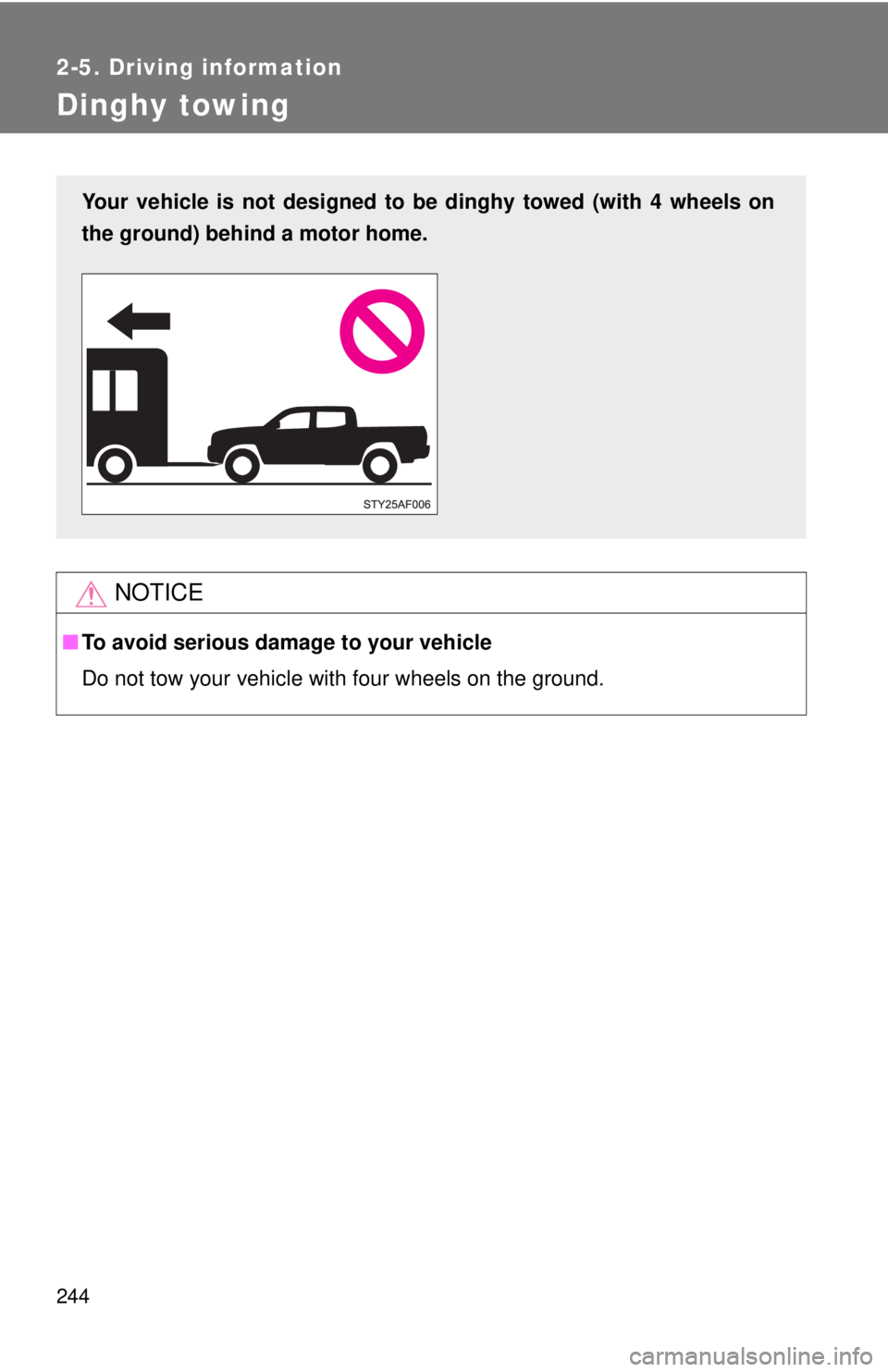
244
2-5. Driving information
Dinghy towing
NOTICE
■To avoid serious damage to your vehicle
Do not tow your vehicle with four wheels on the ground.
Your vehicle is not designed to be dinghy towed (with 4 wheels on
the ground) behind a motor home.
Page 245 of 601
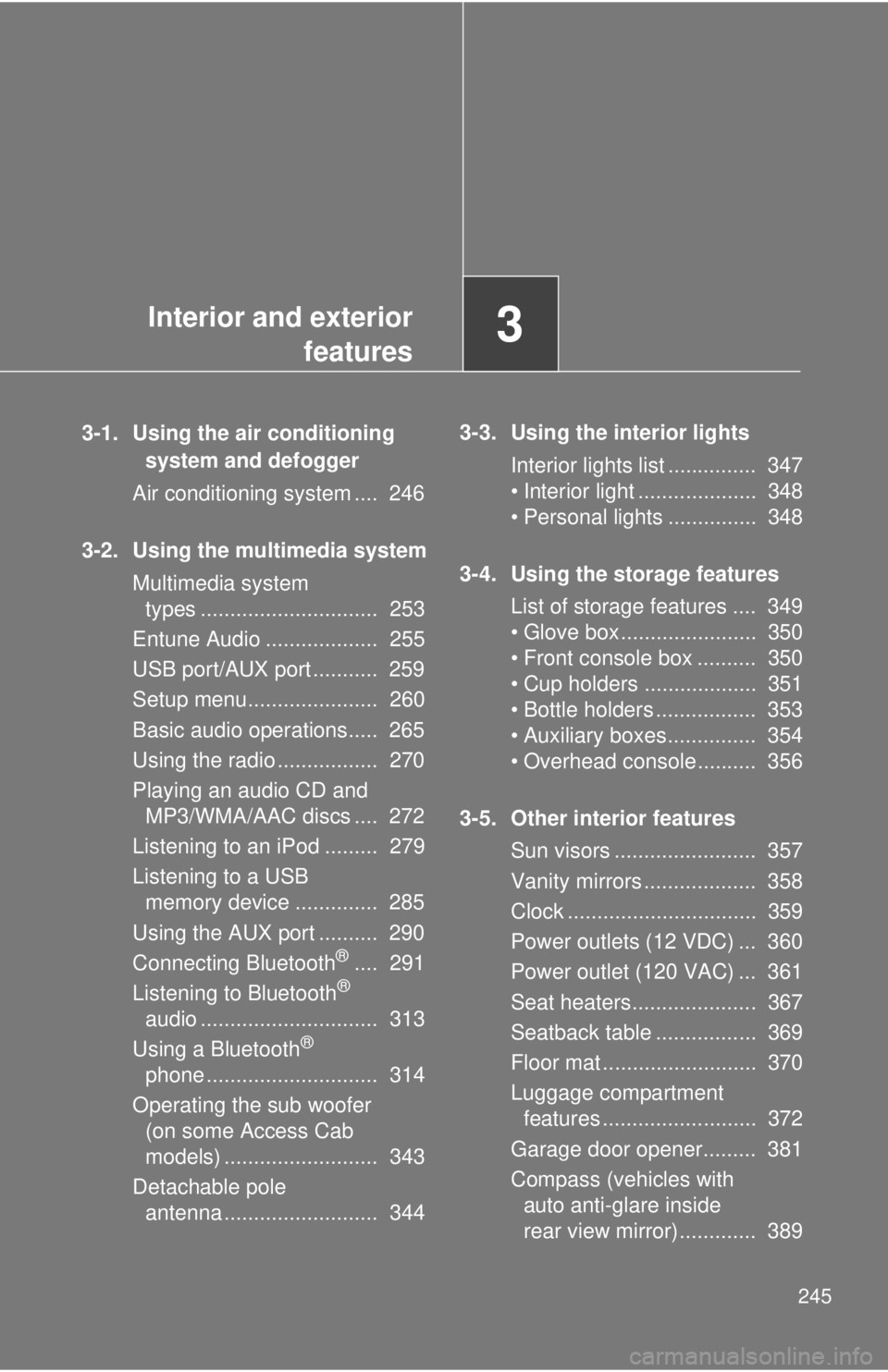
Interior and exteriorfeatures3
245
3-1. Using the air conditioning
system and defogger
Air conditioning system .... 246
3-2. Using the multimedia system Multimedia system types .............................. 253
Entune Audio ................... 255
USB port/AUX port ........... 259
Setup menu...................... 260
Basic audio operations..... 265
Using the radio ................. 270
Playing an audio CD and MP3/WMA/AAC discs .... 272
Listening to an iPod ......... 279
Listening to a USB memory device .............. 285
Using the AUX port .......... 290
Connecting Bluetooth
®.... 291
Listening to Bluetooth®
audio .............................. 313
Using a Bluetooth
®
phone ............................. 314
Operating the sub woofer (on some Access Cab
models) .......................... 343
Detachable pole antenna .......................... 344 3-3. Using the interior lights
Interior lights list ............... 347
• Interior light .................... 348
• Personal lights ............... 348
3-4. Using the storage features List of storage features .... 349
• Glove box....................... 350
• Front console box .......... 350
• Cup holders ................... 351
• Bottle holders ................. 353
• Auxiliary boxes ............... 354
• Overhead console .......... 356
3-5. Other interior features Sun visors ........................ 357
Vanity mirrors ................... 358
Clock ................................ 359
Power outlets (12 VDC) ... 360
Power outlet (120 VAC) ... 361
Seat heaters..................... 367
Seatback table ................. 369
Floor mat .......................... 370
Luggage compartment features .......................... 372
Garage door opener......... 381
Compass (vehicles with auto anti-glare inside
rear view mirror) ............. 389
Page 246 of 601

246
3-1. Using the air conditioning system and defogger
Air conditioning system
Adjusting the settings■ Adjusting the temperature setting
Turn the temperature control dial clockwise (warm) or counter-
clockwise (cool).
If is not pressed, the system will blow ambient temperature air or
heated air.
For quick cooling, turn the temperature control dial to the MAX A/C posi-
tion. The air conditioning will automatically turn on and the air intake
selector will be set to recirculated air mode.
■ Adjusting the fan speed
Turn the fan speed control dial clockwise (increase) or counter-
clockwise (decrease).
Set the dial to OFF to turn the fan off.
Outside air or recirculated
air mode switch Air outlet selection dialAir conditioning
ON/OFF switch Temperature control dial
Fan speed control dial
Page 247 of 601
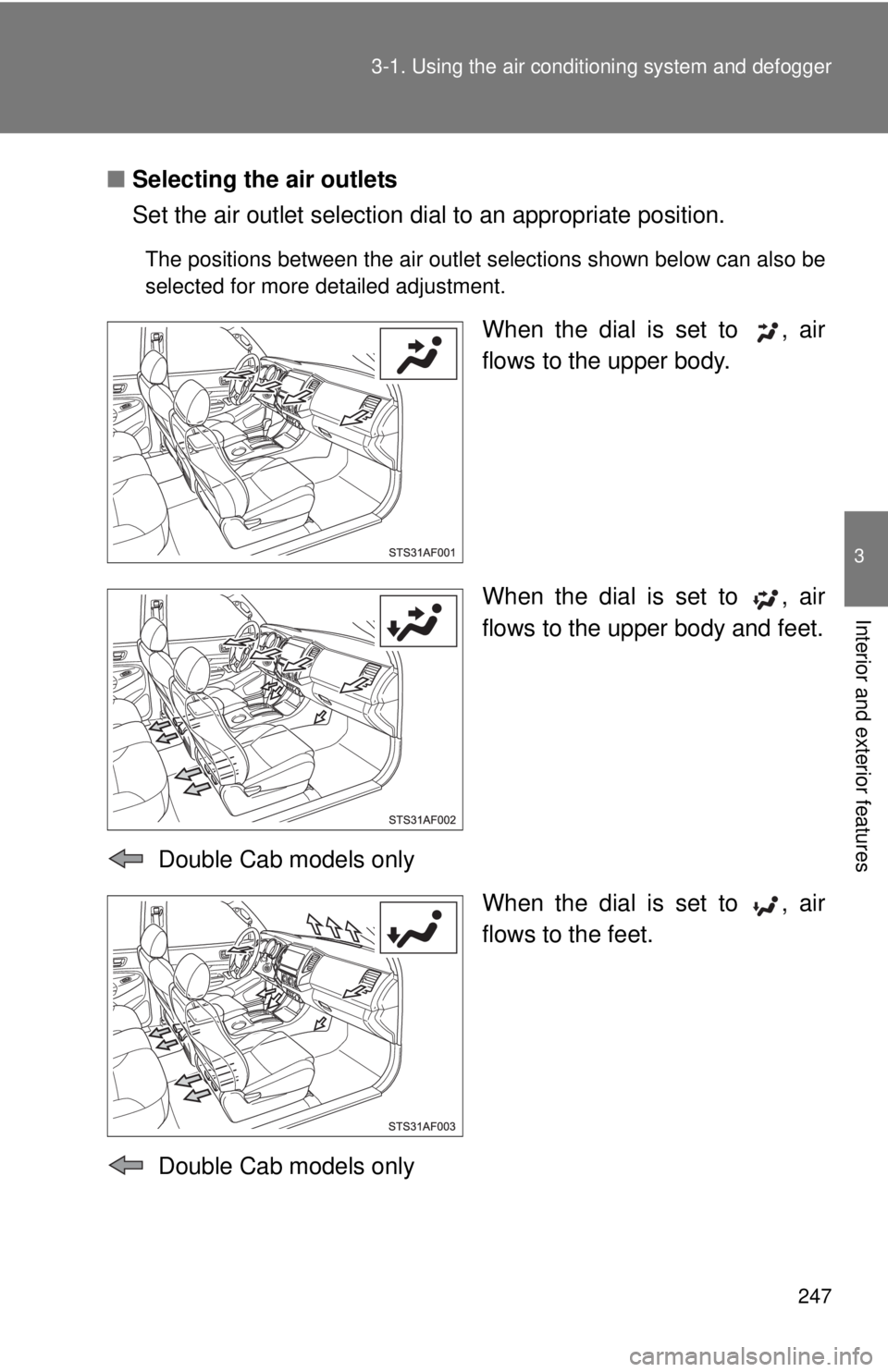
247
3-1. Using the air conditioning system
and defogger
3
Interior and exterior features
■Selecting the air outlets
Set the air outlet selection di al to an appropriate position.
The positions between the air outlet selections shown below can also be
selected for more detailed adjustment.
When the dial is set to , air
flows to the upper body.
When the dial is set to , air
flows to the upper body and feet.
Double Cab models only When the dial is set to , air
flows to the feet.
Double Cab models only
Page 248 of 601
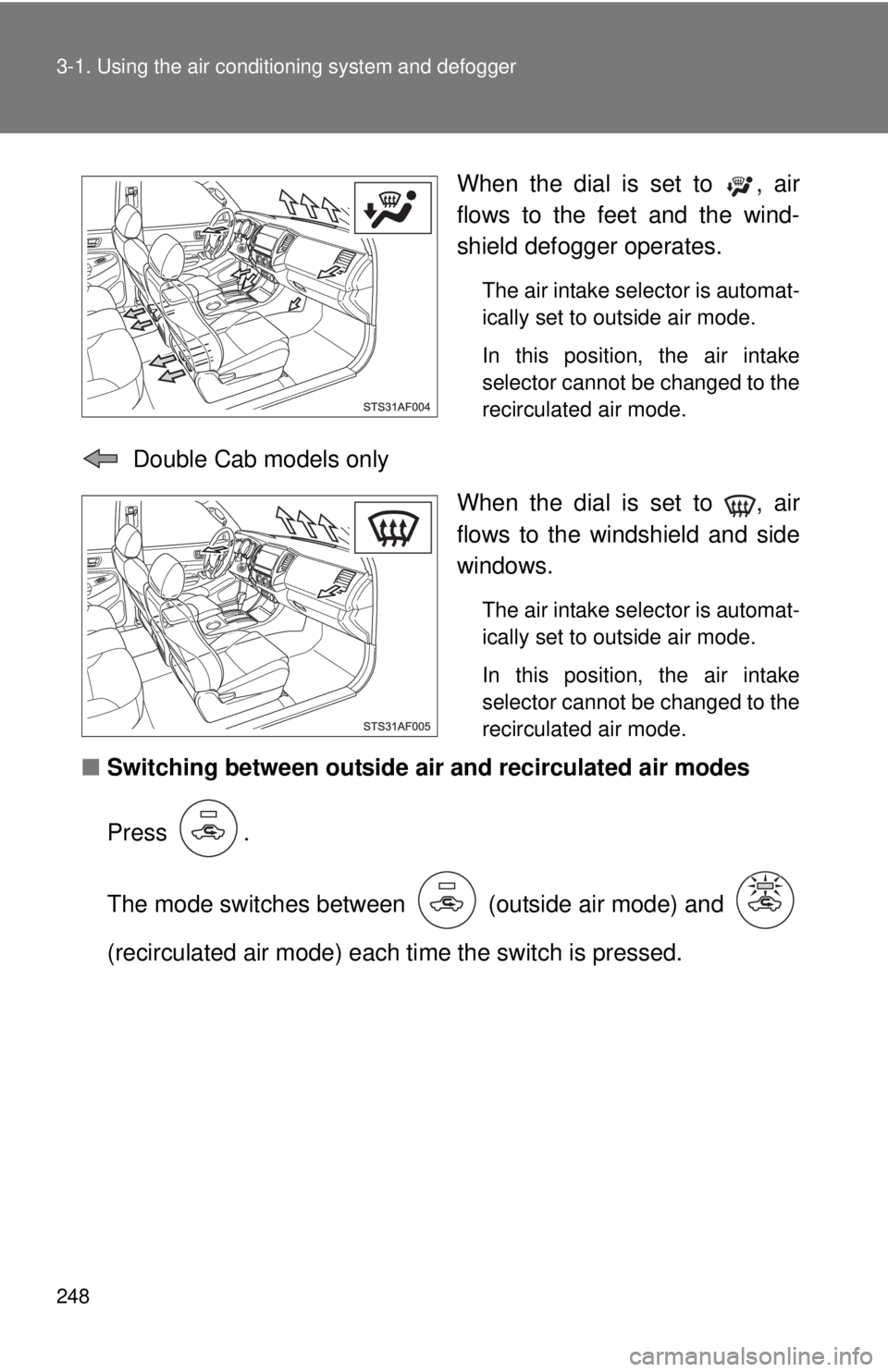
248 3-1. Using the air conditioning system and defogger
When the dial is set to , air
flows to the feet and the wind-
shield defogger operates.
The air intake selector is automat-
ically set to outside air mode.
In this position, the air intake
selector cannot be changed to the
recirculated air mode.
Double Cab models only
When the dial is set to , air
flows to the windshield and side
windows.
The air intake selector is automat-
ically set to outside air mode.
In this position, the air intake
selector cannot be changed to the
recirculated air mode.
■Switching between outside air and recirculated air modes
Press .
The mode switches between (outside air mode) and
(recirculated air mode) each ti me the switch is pressed.
Page 249 of 601
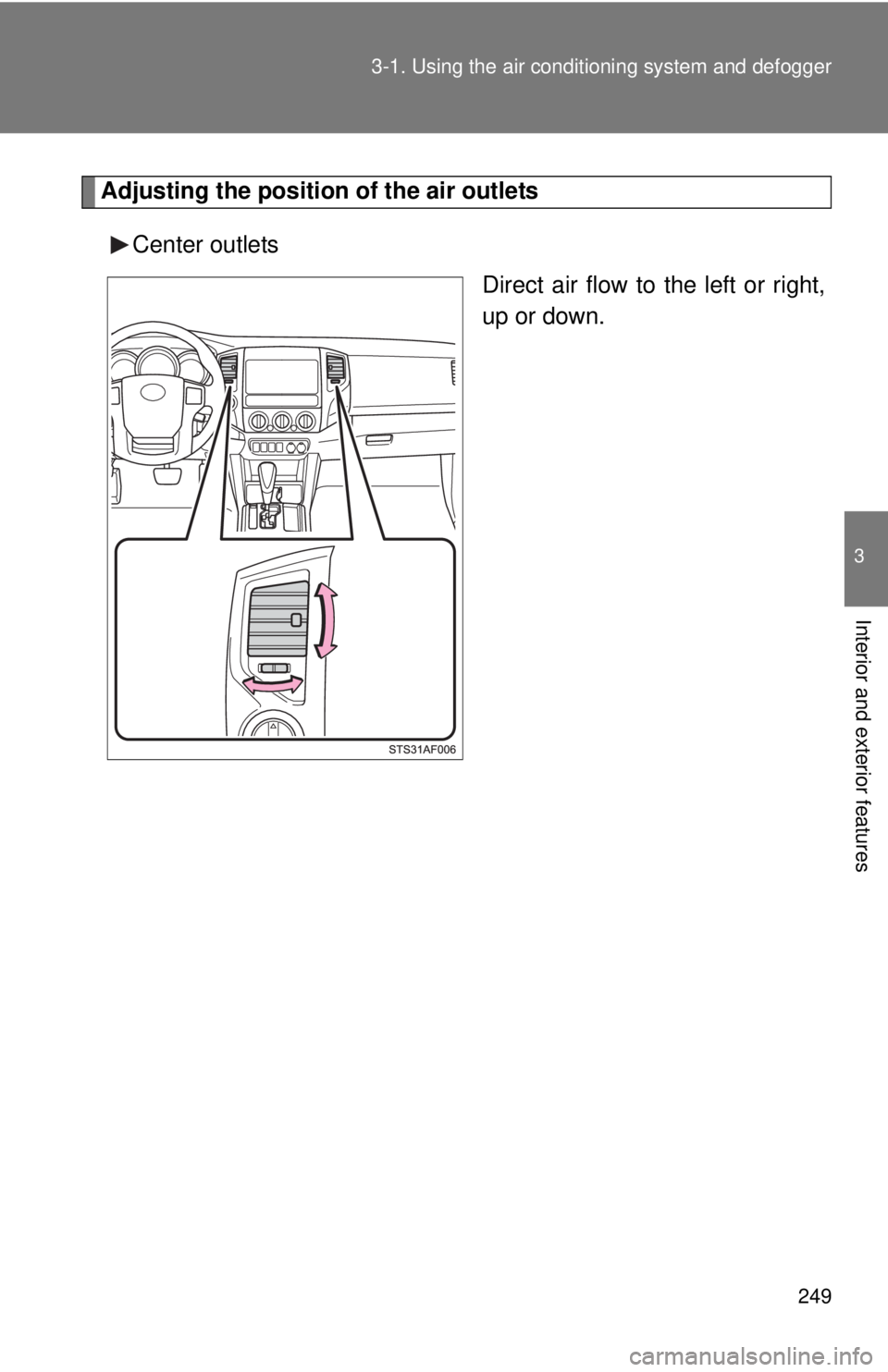
249
3-1. Using the air conditioning system
and defogger
3
Interior and exterior features
Adjusting the position of the air outlets
Center outlets Direct air flow to the left or right,
up or down.
Page 250 of 601
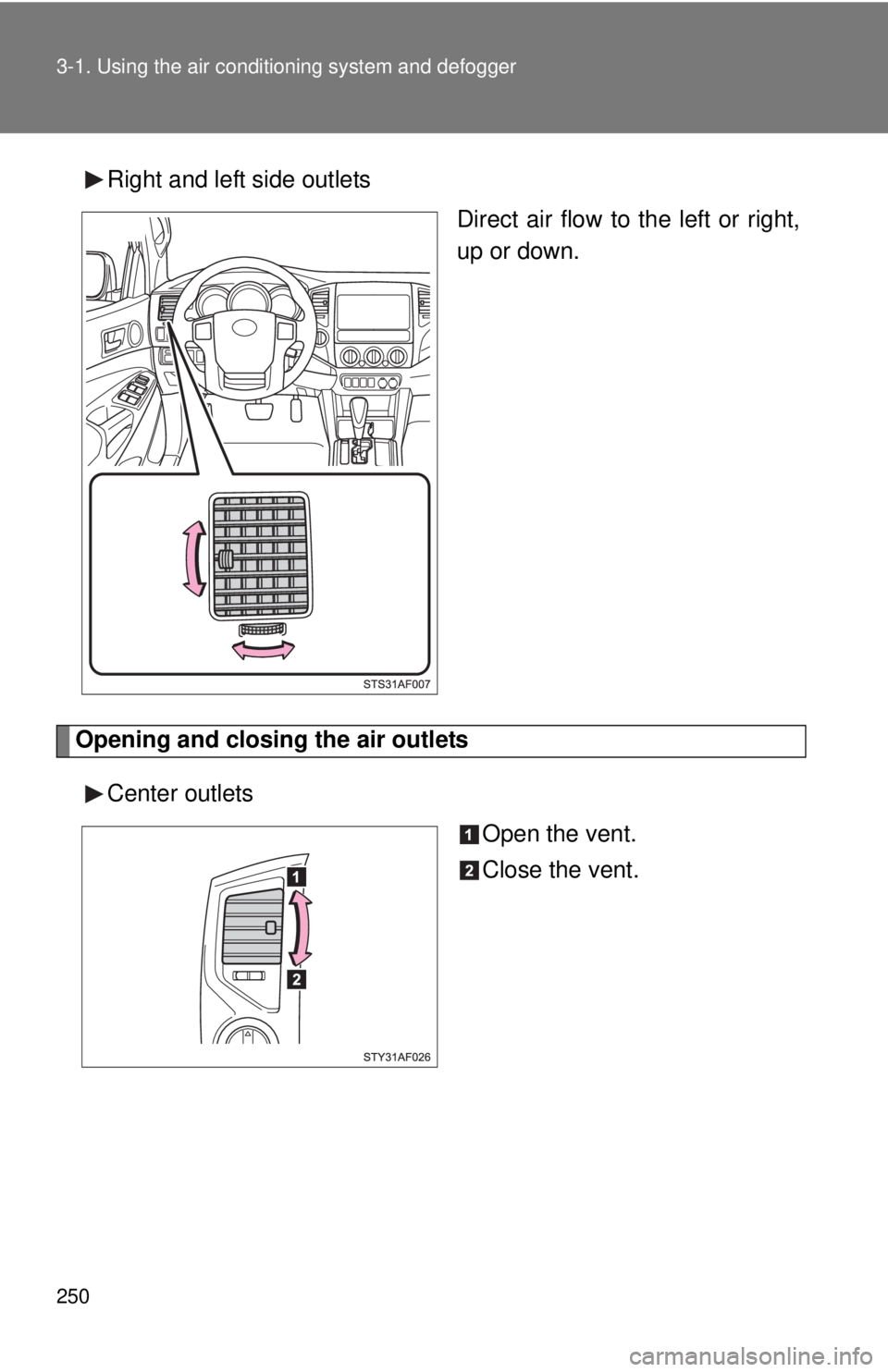
250 3-1. Using the air conditioning system and defogger
Right and left side outlets
Direct air flow to the left or right,
up or down.
Opening and closing the air outlets
Center outlets Open the vent.
Close the vent.